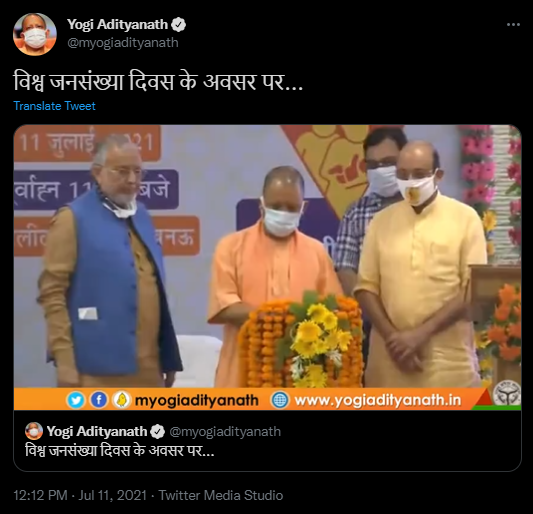On account of the World Population Day observed on 21st July, UP Chief Minister Yogi Adityanath unveiled the ‘New Population Policy’. This announcement was followed by partisan support, opposition and constructive criticisms. Following the introduction and need of the policy, we will be taking a look at the draft of the bill enlisting the foremost provisions concluding with a summary.

Introduction

Uttar Pradesh, India’s most populous state with a population of more than 20 crores, roughly equal to the populations of Germany, the United Kingdom and France combined!!
It is surprising to note that a state with such a high population has a not-so promising fertility rate.
Why Population Control?

A bill, as momentous as this requires a wide premise to support its cause. The reasons for bringing in this bill are as follows:
The fertility rate was the basis in the drafting of this policy which is currently at 2.7 per thousand population(this is calculated as the number of births per 1000 women between the ages of 15-49 in a calendar year).
High population Density: While the population is ever-increasing the land available is, however, constant.
Lack of family planning: -Children in rural areas are considered assets ie more children equates to more earnings. -Due to the lack of awareness, there is no family planning, which in turn affects the upbringing of children as they don’t receive adequate subsistence amenities.
Illiteracy: -Poverty and illiteracy contribute immensely to the population explosion. -The level of female education has a direct impact on fertility. Evidence suggests that the fertility rate of illiterate women is higher than those who are literate. -Lack of education prevents women from having full knowledge about the use of contraceptives, or the consequences of frequent childbirth.
High youth unemployment in India is turning demographic dividend into a demographic disaster.
Does the bill fulfil all the prerequisite concerns of citizens? Let’s find out...
The Bill
The draft of the Uttar Pradesh Population (Control, Stabilisation and Welfare) Bill, 2021 was presented by Uttar Pradesh State Law Commission on their website. It has also been stated that suggestions are invited from the public to improve the draft of the bill.
Provisions
The state population policy will focus on efforts to increase the accessibility of contraceptive measures and the provision of a proper system for safe abortion.
The focus is to include reducing the maternal and infant mortality rates.
Care of the elderly, and better management of education, health, and nutrition of adolescents between 11 to 19 years has also been ensured in the policy.
These provisions will apply to a married couple of legal age.
Goals
The goal of the Bill is to reduce the state’s fertility rate and it has been proposed to help improve the overall welfare of the people of the state, which would lead to sustainable economic development.
The bill would work by conditioning the people through providing incentives and curtailing facilities to followers and non-conformists respectively. Experts comment that government benefits draw people which would eventually lead to the success of the policy whereas there is the risk of backlash with the stringent implementation of the disincentives.
Incentives to Followers
The state government will give promotions, increments, concessions in housing schemes and other perks to employees who adhere to population control norms and have two or fewer children.
"Public servants who adopt the two-child norm will get two additional increments during the entire service, maternity or paternity leave of 12 months, with full salary and allowances and 3% increase in the employer's contribution fund under the National Pension Scheme.
Those who aren't government employees and still adhere to the two-child policy will get benefits in rebates in taxes on water, housing, home loans etc.
If the parent of a child opts for vasectomy, they will be eligible for free medical facilities till the age of 20.
Maternity centres will be set up at all primary health centres
Centres and NGOs will distribute contraceptive pills, condoms, spread awareness about family planning methods through community health workers and ensure mandatory registration of pregnancies, deliveries, births and deaths across the state.
Disincentives to Non-Followers
According to the draft bill, people having more than two children in Uttar Pradesh-
will be debarred from the benefits of all government-sponsored welfare schemes.
won’t be allowed to contest in local polls.
shall be ineligible to apply for government jobs under the state or receive any kind of subsidy.
cannot get a promotion in a government job.
Lastly, their ration card would be limited to four members.

Implementation
The reinforcements are quite a handful and would require immense innovation for implementation which would be in hands of government employees at the district level. Additionally, there will be a ‘Constitution of State Population Fund’ which will be utilised for the purposes of implementation as per the draft.
"Increasing population can be a hurdle in the way of development. Every community has been taken care of in Population Policy 2021-2030," Mr Adityanath said. He also said that population control is directly connected with awareness among the masses and poverty.
Jai Pratap Singh, the state's health minister, said that Uttar Pradesh is aiming for stability by 2050.
The Critique
Uttar Pradesh is not the first state to adopt such a regressive policy in India. Other states like Assam, Madhya Pradesh, Haryana, Rajasthan, and Odisha had also tried this population control technique wherein it was noted that such a two-child policy increased sex-selective and unsafe abortions, giving children up for adoption and men divorcing and deserting their spouse to avoid disqualification.
The policy seems to be impacting women disproportionately and also the poor and marginalised sector of society.
As experts suggest, the following issues need to be tackled for flawless implementation of the policy;
The Bill divides the population into two groups: First, encouraging individuals along with their spouse to go for “voluntary” sterilisation after their two children with government jobs, promotions, education, and increments; and second, debarring individuals with more than two children from applying to government jobs, promotions & subsidies. This makes it hard to ignore whether sterilisation is more “voluntary” or mandatory to avail the opportunities provided here. However, these are measures taken analysing human psychology essentially people would be motivated more to fall in line when baited with the mentioned incentives.
In Uttar Pradesh, almost 32.8% of its population falls below the poverty line and in the current COVID pandemic situation where several people have lost their jobs or are being underpaid, these stringent measures could have an adverse effect immediately on many families.
Many social workers have voiced their opinion that this bill could both better and debilitate women’s health and status. It could increase awareness of women regarding liberty to rear children as per their will and could debilitate their status in areas prone to misogyny and toxic patriarchy.
In such a society it is assumed that the majority burden will be borne by women to undergo sterilisation operations risking their lives.
Conclusion
The success or failure of the policy strongly depends on the implementation of the incentives, sterilisation processes and avoiding corrupt practises as much as possible. A positive lookout here is the suggestion taken by the residents of Uttar Pradesh for the improvement of the said bill. Innovation and triumphant execution by the administration can be extremely fruitful for the state, people and current state government.
Somya Maan
Sources: Draft of the Bill, NDTV, First Post, The Globalist, The Hindu

Comments